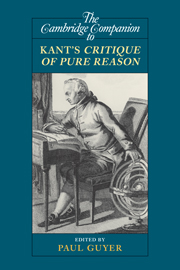Book contents
- Frontmatter
- Introduction
- Part I The Background to the Critique
- Part II The Arguments of the Critique
- 3 The Introduction to the Critique: Framing the Question
- 4 The Transcendental Aesthetic
- 5 The Deduction of the Categories: The Metaphysical and Transcendental Deductions
- 6 The System of Principles
- 7 The Refutation of Idealism and the Distinction between Phenomena and Noumena
- 8 The Ideas of Pure Reason
- 9 The Paralogisms of Pure Reason
- 10 The Antinomies of Pure Reason
- 11 The Ideal of Pure Reason
- 12 The Appendix to the Dialectic and the Canon of Pure Reason: The Positive Role of Reason
- 13 The Transcendental Doctrine of Method
- Part III The Impact of the Critique
- Bibliography
- Index
7 - The Refutation of Idealism and the Distinction between Phenomena and Noumena
from Part II - The Arguments of the Critique
Published online by Cambridge University Press: 28 July 2010
- Frontmatter
- Introduction
- Part I The Background to the Critique
- Part II The Arguments of the Critique
- 3 The Introduction to the Critique: Framing the Question
- 4 The Transcendental Aesthetic
- 5 The Deduction of the Categories: The Metaphysical and Transcendental Deductions
- 6 The System of Principles
- 7 The Refutation of Idealism and the Distinction between Phenomena and Noumena
- 8 The Ideas of Pure Reason
- 9 The Paralogisms of Pure Reason
- 10 The Antinomies of Pure Reason
- 11 The Ideal of Pure Reason
- 12 The Appendix to the Dialectic and the Canon of Pure Reason: The Positive Role of Reason
- 13 The Transcendental Doctrine of Method
- Part III The Impact of the Critique
- Bibliography
- Index
Summary
In the “Refutation of Idealism” that he added to the second edition of the Critique of Pure Reason, Kant claims to refute what he calls problematic idealism. According to Kant, problematic idealism is a position, traceable to Descartes, which “declares the existence of objects in space outside us to be [ . . . ] doubtful and indemonstrable” (B 274). Against this position, Kant wants to prove “that even our inner experience, undoubted by Descartes, is possible only on the presupposition of outer experience” (B 275). Kant presents the following argument for this thesis: “(1) “I am conscious of my existence as determined in time” (B 275). / (2) “All time-determination presupposes something persistent in perception” (B 275). / (3) “This persisting thing, however, cannot be something in me, since my own existence in time can first be determined only through this persisting thing” (B 275). / (4) “Thus the perception of this persistent thing is possible only through a thing outside me” (B 275). / (5) “Consequently, the determination of my existence in time is possible only by means of the existence of actual things that I perceive outside me” (B 275).”
- Type
- Chapter
- Information
- The Cambridge Companion to Kant's Critique of Pure Reason , pp. 168 - 189Publisher: Cambridge University PressPrint publication year: 2010
- 6
- Cited by



